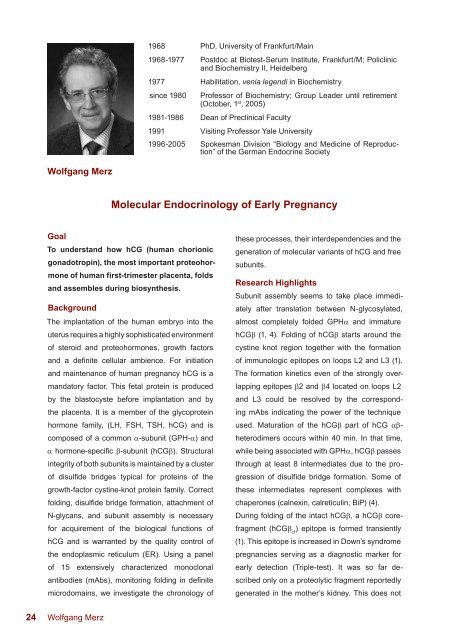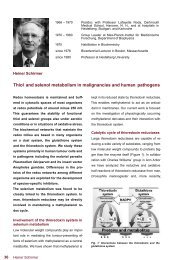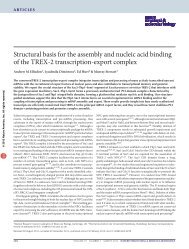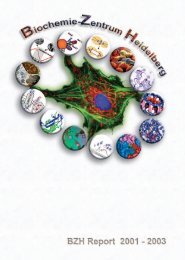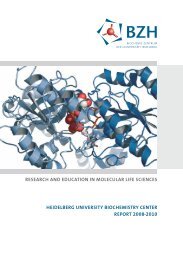Biochemie-Zentrum der Universität Heidelberg (BZH)
Biochemie-Zentrum der Universität Heidelberg (BZH)
Biochemie-Zentrum der Universität Heidelberg (BZH)
You also want an ePaper? Increase the reach of your titles
YUMPU automatically turns print PDFs into web optimized ePapers that Google loves.
Wolfgang Merz<br />
Goal<br />
To un<strong>der</strong>stand how hCG (human chorionic<br />
gonadotropin), the most important proteohor-<br />
mone of human first-trimester placenta, folds<br />
and assembles during biosynthesis.<br />
Background<br />
The implantation of the human embryo into the<br />
uterus requires a highly sophisticated environment<br />
of steroid and proteohormones, growth factors<br />
and a definite cellular ambience. For initiation<br />
and maintenance of human pregnancy hCG is a<br />
mandatory factor. This fetal protein is produced<br />
by the blastocyste before implantation and by<br />
the placenta. It is a member of the glycoprotein<br />
hormone family, (LH, FSH, TSH, hCG) and is<br />
composed of a common a-subunit (GPH-a) and<br />
a hormone-specific b-subunit (hCGb). Structural<br />
integrity of both subunits is maintained by a cluster<br />
of disulfide bridges typical for proteins of the<br />
growth-factor cystine-knot protein family. Correct<br />
folding, disulfide bridge formation, attachment of<br />
N-glycans, and subunit assembly is necessary<br />
for acquirement of the biological functions of<br />
hCG and is warranted by the quality control of<br />
the endoplasmic reticulum (ER). Using a panel<br />
of 15 extensively characterized monoclonal<br />
antibodies (mAbs), monitoring folding in definite<br />
microdomains, we investigate the chronology of<br />
24 Wolfgang Merz<br />
1968 PhD, University of Frankfurt/Main<br />
1968-1977 Postdoc at Biotest-Serum Institute, Frankfurt/M; Policlinic<br />
and Biochemistry II, <strong>Heidelberg</strong><br />
1977 Habilitation, venia legendi in Biochemistry<br />
since 1980 Professor of Biochemistry; Group Lea<strong>der</strong> until retirement<br />
(October, 1 st , 2005)<br />
1981-1986 Dean of Preclinical Faculty<br />
1991 Visiting Professor Yale University<br />
1996-2005 Spokesman Division “Biology and Medicine of Repro duction”<br />
of the German Endocrine Society<br />
Molecular Endocrinology of Early Pregnancy<br />
these processes, their interdependencies and the<br />
generation of molecular variants of hCG and free<br />
subunits.<br />
Research Highlights<br />
Subunit assembly seems to take place immediately<br />
after translation between N-glycosylated,<br />
almost completely folded GPHa and immature<br />
hCGb (1, 4). Folding of hCGb starts around the<br />
cystine knot region together with the formation<br />
of immunologic epitopes on loops L2 and L3 (1).<br />
The formation kinetics even of the strongly overlapping<br />
epitopes b2 and b4 located on loops L2<br />
and L3 could be resolved by the corresponding<br />
mAbs indicating the power of the technique<br />
used. Maturation of the hCGb part of hCG abheterodimers<br />
occurs within 40 min. In that time,<br />
while being associated with GPHa, hCGb passes<br />
through at least 8 intermediates due to the progression<br />
of disulfide bridge formation. Some of<br />
these intermediates represent complexes with<br />
chaperones (calnexin, calreticulin, BiP) (4).<br />
During folding of the intact hCGb, a hCGb corefragment<br />
(hCGb ) epitope is formed transiently<br />
cf<br />
(1). This epitope is increased in Down’s syndrome<br />
pregnancies serving as a diagnostic marker for<br />
early detection (Triple-test). It was so far described<br />
only on a proteolytic fragment reportedly<br />
generated in the mother’s kidney. This does not


